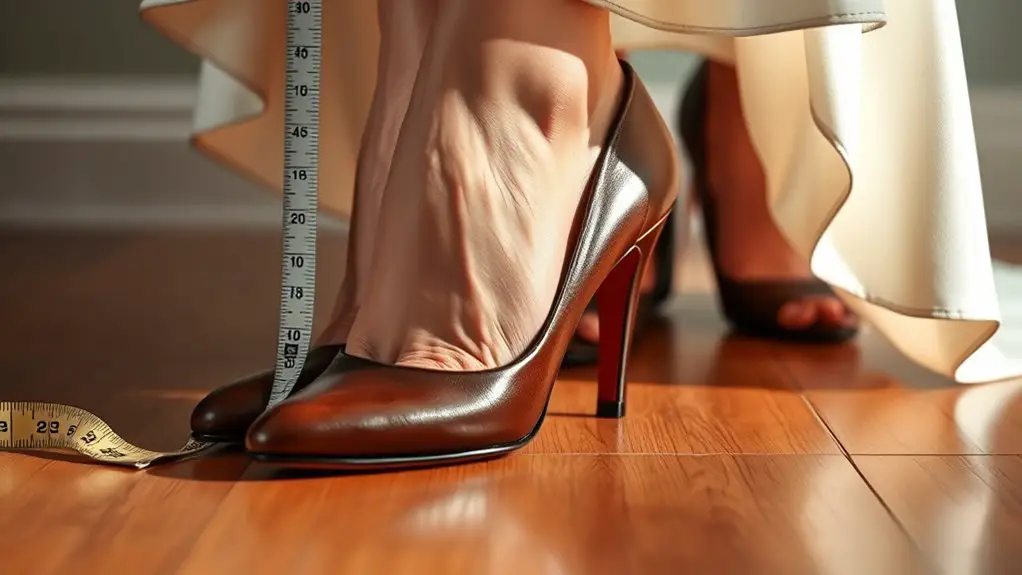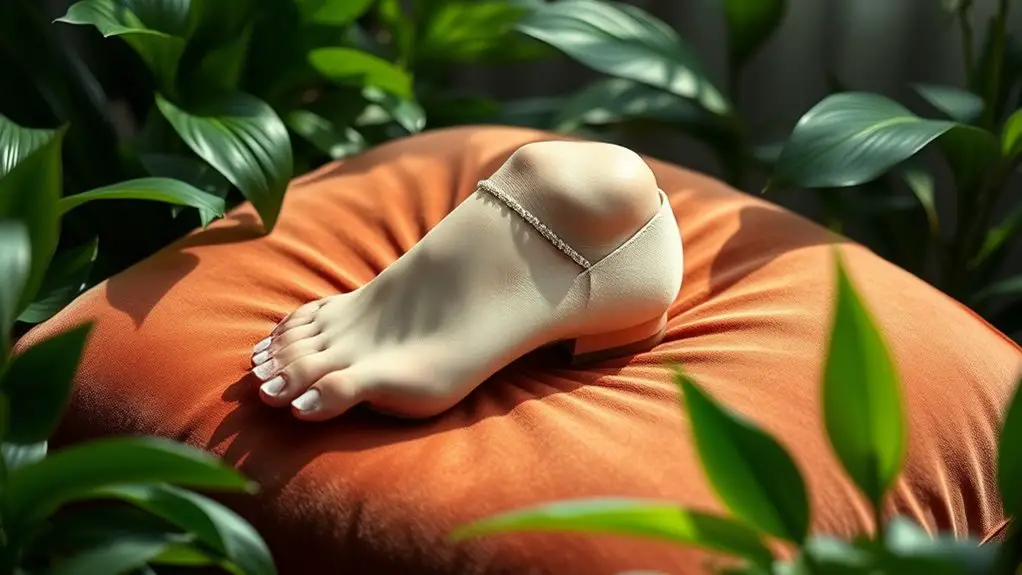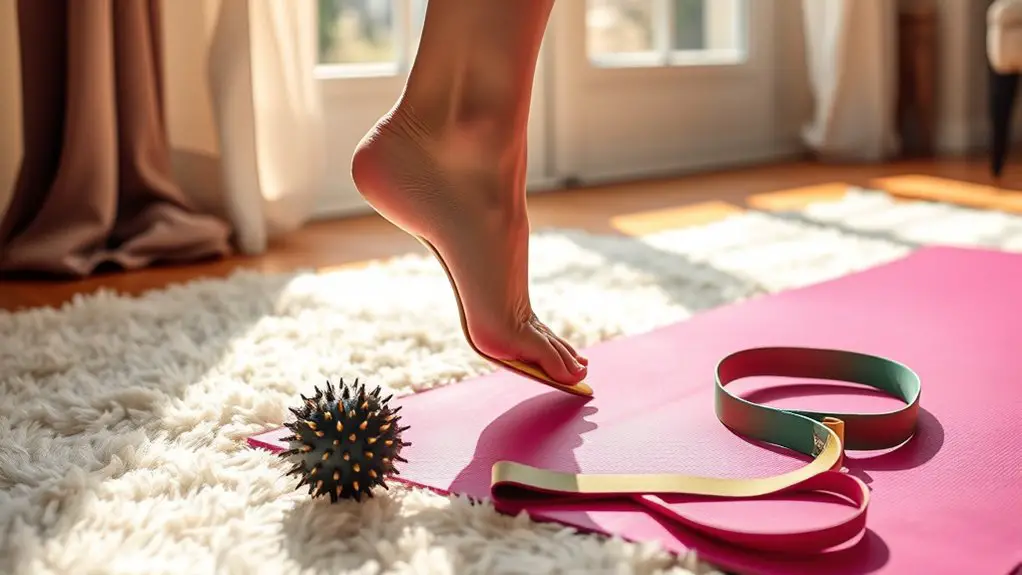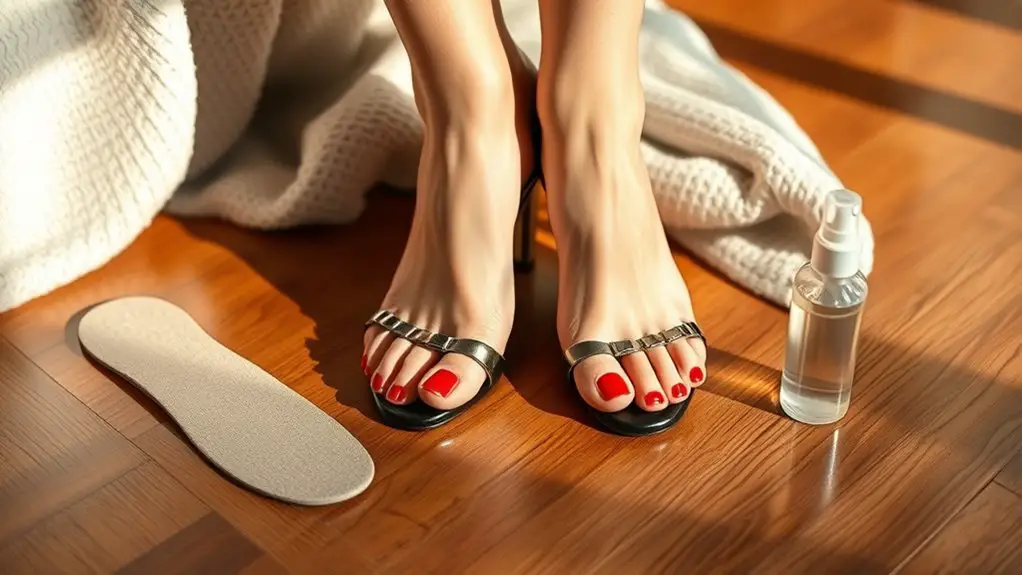To keep your feet healthy while often wearing heels, start by choosing the right size and fit. Opt for quality materials that provide support and comfort. Limit heel height to two or three inches to reduce strain. Incorporate cushioning with gel insoles to absorb shock and prevent discomfort. Practice foot exercises for flexibility, take breaks from heels, and alternate footwear. Finally, always keep your feet clean and moisturized. There’s more to discover to enhance your foot health while wearing heels.
Choose the Right Size and Fit

Choosing the right size and fit for your heels is vital for maintaining foot health, and it can make all the difference in comfort. Start by taking accurate foot measurements, as many people wear the wrong size without realizing it. Measure both the length and width of your feet, since sizes can vary across brands.
Next, pay close attention to the toe box. A cramped toe box can lead to painful conditions like bunions and corns, so make sure it provides enough space for your toes to move comfortably. Ideally, your heels should fit snugly without slipping, while the toe box should allow for a little wiggle room.
When trying on heels, walk around to assess comfort and stability—your feet should feel supported. Remember, finding the right size and fit isn’t just about style; it’s important for your foot health in the long run.
Opt for Quality Materials
Even with the perfect fit, the materials used in your heels can greatly impact your foot health. When selecting heels, pay attention to the leather types used. High-quality leather not only molds to your foot over time but also provides essential support. Avoid synthetic materials that can cause discomfort and restrict movement.
Additionally, opting for breathable fabrics is vital, especially if you plan to wear your heels for extended periods. Breathable materials help maintain airflow, reducing moisture buildup and the risk of fungal infections. Look for shoes lined with soft, moisture-wicking fabrics that promote comfort.
Investing in well-crafted heels made from quality materials can make a significant difference in your overall foot health. By prioritizing leather types and breathable options, you’re setting yourself up for a more comfortable and supportive experience, allowing you to enjoy your stylish footwear without compromising your well-being.
Limit Heel Height

When it comes to heels, aiming for a height of no more than two to three inches can make a significant difference in your foot health. Choosing a lower heel height helps to maintain a better comfort balance, reducing strain on your feet, ankles, and lower back. Higher heels shift your body weight forward, which can lead to discomfort and long-term issues such as plantar fasciitis and metatarsalgia.
When selecting heels, consider your daily activities and the amount of time you’ll be wearing them. Opting for a moderate heel height allows you to enjoy the elegance of heels while minimizing the risk of injury. It’s also wise to gradually increase your heel height over time, giving your feet a chance to adapt. Prioritizing comfort in your heel choices will not only support your foot health but also enhance your overall confidence and poise while wearing them.
Incorporate Cushioning
Cushioning is vital for maintaining comfort and support in heels. To achieve this, consider using gel insoles that provide an extra layer of soft padding. These insoles help absorb shock, reducing pressure on your feet as you walk. When choosing gel insoles, look for options with built-in arch support. This feature helps distribute your weight evenly and alleviates strain on your arches, which is important when wearing heels for extended periods.
Incorporating cushioning into your footwear can greatly enhance your overall experience. It not only makes wearing heels more comfortable but also helps prevent common foot issues like blisters and calluses. Make sure your insoles fit snugly within your shoes, as improper placement can negate their benefits. By prioritizing cushioning and arch support, you’ll keep your feet healthier and more comfortable, allowing you to confidently enjoy your favorite heels without sacrificing foot health.
Practice Foot Exercises

Incorporating cushioning into your heels is just one way to enhance comfort; practicing foot exercises can greatly contribute to your foot health as well. Regularly engaging in stretching techniques helps maintain flexibility in your feet, which is essential when you’re often in heels. Simple stretches like toe points and ankle rolls can alleviate tension and improve circulation.
In addition to stretching, focus on foot strengthening exercises. Try picking up small objects with your toes or doing calf raises to build strength in the muscles that support your arches. These exercises not only help prevent injury but also improve your balance and stability, making it easier to walk gracefully in heels.
Take Breaks and Alternate Footwear
Although wearing heels can elevate your style, it’s essential to recognize the importance of taking breaks and alternating your footwear. Practicing footwear rotation can greatly reduce strain on your feet. Consider designating specific days as heel free days, allowing your feet to recover and breathe. By mixing up your shoe choices, you can alleviate pressure on the same areas and prevent discomfort.
Here’s a simple table to help you plan your footwear rotation:
| Day | Footwear Option | Duration |
|---|---|---|
| Monday | Heels | 4 hours |
| Tuesday | Flats | All day |
| Wednesday | Heels | 4 hours |
| Thursday | Sneakers | All day |
Incorporating this strategy into your routine can enhance comfort and support your foot health while still enjoying your favorite heels.
Keep Feet Clean and Moisturized
Maintaining clean and moisturized feet is essential for overall foot health, especially when frequently wearing heels. Good foot hygiene helps prevent issues like calluses, blisters, and fungal infections. Start by washing your feet daily with mild soap and warm water, paying special attention to the areas between your toes. After drying, use a pumice stone to gently exfoliate any rough patches.
Implement a moisturizing routine to keep your skin supple and hydrated. Choose a quality foot cream or lotion, applying it daily, particularly after your evening shower. Massage the moisturizer into your feet, focusing on dry areas and heels. Consider wearing cotton socks overnight to enhance absorption. Additionally, don’t forget to keep your toenails trimmed and clean, as this also contributes to better foot health. By prioritizing cleanliness and hydration, you’ll not only feel more comfortable in your heels but also maintain healthier feet in the long run.
Pay Attention to Pain Signals
When you wear heels, it’s crucial to pay attention to any pain signals your feet may send you. Ignoring discomfort can lead to long-term issues. Here are some tips for effective pain recognition and discomfort management:
- Listen to Your Feet: If you feel pain, take it seriously. Don’t dismiss it as just a part of wearing heels.
- Adjust Your Fit: Confirm your heels fit properly; tight shoes can cause blisters and other ailments.
- Limit Wear Time: Try to alternate your footwear. Give your feet a break by switching to flats or sneakers when possible.
- Utilize Supportive Inserts: Consider gel pads or orthotics to cushion your feet and reduce pressure.
Frequently Asked Questions
Can Wearing Heels Affect My Posture Negatively?
Did you know that 72% of women experience posture issues from wearing heels? Poor heel support can disrupt your posture alignment, leading to back pain and discomfort. It’s essential to choose supportive footwear for healthier feet.
How Often Should I Replace My Heels?
You should replace your heels every six to twelve months, depending on their heel lifespan and how often you wear them. Regular shoe maintenance can extend their life, but don’t ignore signs of wear and tear.
Are There Specific Heel Styles That Are Better for Foot Health?
Certain heel styles, like wedges or block heels, often provide better support. Opt for shoes with quality heel material options and consider adding supportive insoles to enhance comfort and promote foot health during prolonged wear.
What Type of Socks Can I Wear With Heels for Comfort?
You can wear cushioned ankle socks with heels for added comfort. Look for options with cushioned insoles that provide extra support and reduce friction, helping to prevent blisters and enhance your overall foot health while wearing heels.
Can Heel Height Impact My Balance and Stability?
Like a tightrope walker, heel height can greatly impact your balance and stability. When wearing higher heels, consider incorporating balance training exercises to strengthen your muscles, helping you maintain stability and prevent potential falls or injuries.



